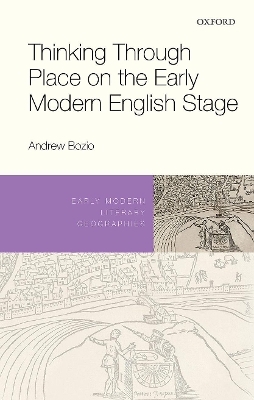
Thinking Through Place on the Early Modern English Stage
Seiten
2020
Oxford University Press (Verlag)
978-0-19-884656-7 (ISBN)
Oxford University Press (Verlag)
978-0-19-884656-7 (ISBN)
The way that characters in early modern theatrical performance think through their surroundings is important in our understanding of perception, memory, and other forms of embodied affective thought. This book explores this concept in dramatic works by Marlowe, Shakespeare, Beaumont, and Jonson.
Thinking Through Place on the Early Modern English Stage argues that environment and embodied thought continually shaped one another in the performance of early modern English drama. It demonstrates this, first, by establishing how characters think through their surroundings — not only how they orient themselves within unfamiliar or otherwise strange locations, but also how their environs function as the scaffolding for perception, memory, and other forms of embodied thought. It then contends that these moments of thinking through place theorise and thematise the work that playgoers undertook in reimagining the stage as the setting of the dramatic fiction. By tracing the relationship between these two registers of thought in such plays as The Malcontent, Dido Queen of Carthage, Tamburlaine, King Lear, The Knight of the Burning Pestle, and Bartholomew Fair, this book shows that drama makes visible the often invisible means by which embodied subjects acquire a sense of their surroundings. It also reveals how, in doing so, theatre altered the way that playgoers perceived, experienced, and imagined place in early modern England.
Thinking Through Place on the Early Modern English Stage argues that environment and embodied thought continually shaped one another in the performance of early modern English drama. It demonstrates this, first, by establishing how characters think through their surroundings — not only how they orient themselves within unfamiliar or otherwise strange locations, but also how their environs function as the scaffolding for perception, memory, and other forms of embodied thought. It then contends that these moments of thinking through place theorise and thematise the work that playgoers undertook in reimagining the stage as the setting of the dramatic fiction. By tracing the relationship between these two registers of thought in such plays as The Malcontent, Dido Queen of Carthage, Tamburlaine, King Lear, The Knight of the Burning Pestle, and Bartholomew Fair, this book shows that drama makes visible the often invisible means by which embodied subjects acquire a sense of their surroundings. It also reveals how, in doing so, theatre altered the way that playgoers perceived, experienced, and imagined place in early modern England.
Andrew Bozio is Assistant Professor of English at Skidmore College, where he teaches courses on early modern English drama and literary theory.
Introduction: Thinking Through Place on the Early Modern English Stage
1: Forms of Emplacement: The Arts of Memory, Chorography, and Theatrical Performance
2: Marlowe and the Ecology of Remembrance
3: The Perception of Place in King Lear
4: Staging Failure: Disorientation in The Knight of the Burning Pestle
5: Bartholomew Fair and the Performativity of Place
Conclusion: 'no need of place'
| Erscheinungsdatum | 25.03.2020 |
|---|---|
| Reihe/Serie | Early Modern Literary Geographies |
| Verlagsort | Oxford |
| Sprache | englisch |
| Maße | 145 x 223 mm |
| Gewicht | 428 g |
| Themenwelt | Geisteswissenschaften ► Sprach- / Literaturwissenschaft ► Anglistik / Amerikanistik |
| Geisteswissenschaften ► Sprach- / Literaturwissenschaft ► Literaturgeschichte | |
| Geisteswissenschaften ► Sprach- / Literaturwissenschaft ► Literaturwissenschaft | |
| ISBN-10 | 0-19-884656-8 / 0198846568 |
| ISBN-13 | 978-0-19-884656-7 / 9780198846567 |
| Zustand | Neuware |
| Haben Sie eine Frage zum Produkt? |
Mehr entdecken
aus dem Bereich
aus dem Bereich
Poetik eines sozialen Urteils
Buch | Hardcover (2023)
De Gruyter (Verlag)
CHF 83,90
Buch | Softcover (2024)
belleville (Verlag)
CHF 27,95


